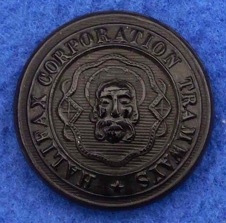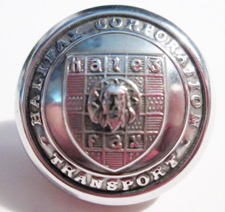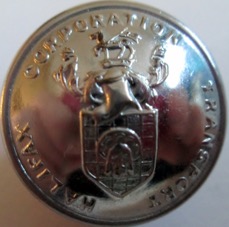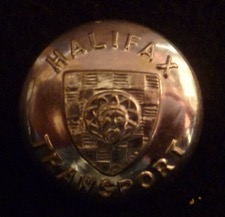Halifax Corporation Tramways
Owner Halifax Corporation
Opened 9th June 1898 (electric)
Operator Halifax Corporation
Department renamed 17th October 1937 (to Halifax Passenger Transport Department)
Closed 14th February 1939
Length 39.07 miles
Gauge 3ft 6ins
Button description (Pattern 1) Title (‘HALIFAX CORPORATION TRAMWAYS’) within a raised rim, surrounding the head of John the Baptist within a stylised circle.
Materials known Brass; nickel; black horn
Button Line reference [113/32]
Button description (Pattern 2) Title (‘HALIFAX CORPORATION TRANSPORT’) within a border with a raised rim, surrounding a shield bearing the head of John the Baptist and the words ‘halez’ and ‘fax’
Materials known Chrome
Button Line reference [None]
Button description (Pattern 3) Title (‘HALIFAX CORPORATION TRANSPORT’) surrounding a shield bearing the head of John the Baptist, surmounted by a helmet, crown and lamb
Materials known Chrome
Button Line reference [None]
Button description (Pattern 4) Title (‘HALIFAX TRANSPORT’) surrounding a shield bearing the head of John the Baptist
Materials known Chrome
Button Line reference [None]
Comments The corporation's 'Tramways Committee' formally changed its name to the 'Passenger Transport Committee' in late 1937, only 16 months before the final tramway abandonment. It is therefore possible that tramcar crews were issued with uniforms bearing the Pattern 2 button. The municipal device on the Pattern 3 button contains elements of the council's new arms, which were granted in 1948, so well after the demise of the tramway. The Pattern 4 button almost certainly superseded the Pattern 3 button, both being shown for interest only.
The somewhat unexpected appearance of John the Baptist's head on the Halifax Coat of Arms stems from the legend that his head is buried there! Who knows whether the legend was born from the mistaken belief that 'Halifax' derived from 'holy' and 'face', or whether the legend was there beforehand and the name was conveniently made to fit the legend. Whatever the case, the name actually derives from the words 'holy' and 'flax' (field) and is attested as such in early records.



